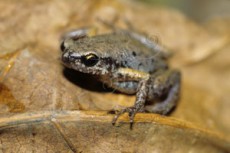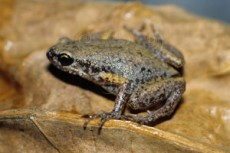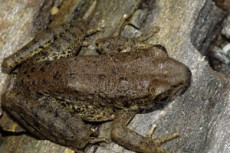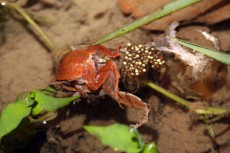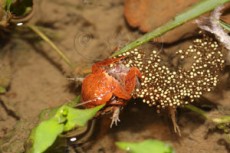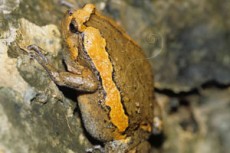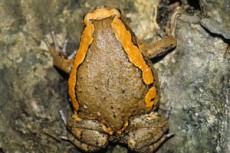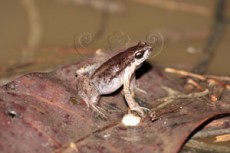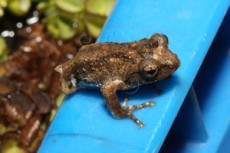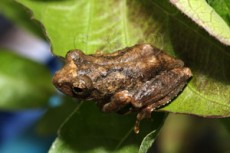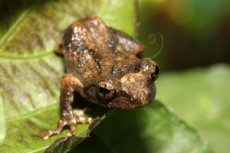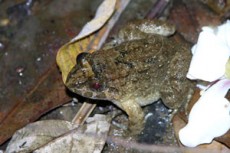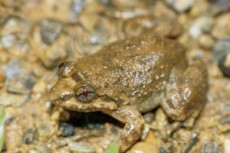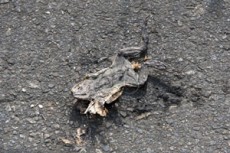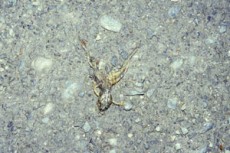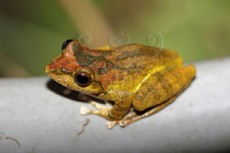TELDAP Collections
| Learning Resources – General Concepts on Amphibians |
|
001 The Origin Frogs, salamanders and caecilians composed of the amphibians today, and they have exhibited surprising changes: some animals have tails while others do not; some have snake- or lizard-like appearances while others jumps with slim hind legs or dig caves completely without legs. Body colors range from pale brown to bright blue, green and red. Among the forty thousand species of vertebrates (animals with spine), the amphibians occupies five thousand four hundred. They are the most trivial class among the modern vertebrates next to the mammals, but were the dominant population among the terrestrial animals – the descendant of some mid-sized alligators that flourished many millions of years ago. Amphibians are a rather important group for research because they are the descendants of the vertebrates that first conquered the earth, which led to the appearance of reptiles thereafter (mammals and birds followed the reptiles). The amphibians can be classified into three orders: order Caudata (salamanders that include newts and sirens, a total of 473 species), order Anura (frogs including toads, a total of 4750 species), and order Gymnophiona (caecilians that look like eels, a total of 176 species), for a total of 5399 species. In fact, the number of species that are being discovered are increasing rapidly in recent years due to the following factors: the surveying of the regions that were undeveloped in the past, the use of non-morphological features to identify species (such as molecular and behavioral), and the changes in the environment that hastened the researchers’ pace to study the species before they become extinct. “Amphibian” comes from ancient Greek work “amphibious” which mean organisms with two modes of living; to be more specific, they are organisms with alternate lives on land and in water. This two-ways of living is a rule for the life forms in the amphibian class, however, exceptions can be found that some organisms are either permanently aquatic or terrestrial. All amphibians are ectothermal animals which use ambient temperatures to regulate body temperature. Since they do not have feather-like structures like the birds to define themselves, we have to rely on several characteristics to classify amphibians. In other words, this means that a significant gap is found between the present day species and the fossils formed long ago, and that information is missing for us to rely on in some of the key features on the fossil morphologies. In reality, amphibians we are trying to define now do not include the earliest terrestrial vertebrates. However, in order to learn the origin of amphibians, we have to consider the earliest four-legged vertebrates (tetrapod). 002 Fossil Records The ancestors of the early tetrapod were bony fish (class Osteichthyes) from class Sarcopterygii (fish with fleshy fin). Unlike most bony fish that has cartilaginous supported fins (such as class Actinopterygii, ray-finned fish, and including most of the fish today), the fins of Sarcopterygii have portions of bone that are similar to the appendages of terrestrial animals. In addition, the Sarcopterygii have developed the “lung” for tetrapod (although they have little relevance to a group of lung fish in the class Dipneusti); some may even have internal nares (nostrils), which allow them to bring air to the lungs when they close their mouths or expose their external nares above water. Internal nares are the characteristic of terrestrial vertebrates; most external nares on fish provide sensual functions only. Genus Ichthyostega is very similar to an extinct fish – genus Eusthenopteron (family Osteolepidae); both were found in the sediments in the Devonian Period from Quebec, Canada. The two fishes have both lungs and internal nares, and have the features found in some of the Osteolepiformes and early tetrapods: 1) a skull that is horizontally divided into anterior and posterior portions; 2) teeth with enamel coatings that curves inwards which forms a complex appearance looked at from a cross-section. This extinct fish was the closest in relationship to tetrapods, but not known to most people is that there were two genera categorized as family Osteolepiformes: genus Elpistostege in Quebec, Canada, and genus Panderichthys (family Panderichthyidae) in Eastern Europe. There is no doubt that genus Ichthyostega is a tetrapod but has retained some of the same characteristics of fish. Among these features, the operculum – the residual bony flap connecting the gill flap and the cheek, and the caudal fin, are supported by radial bones. However, the appendages and girdle structure in the Ichthyostega has completely evolved to the state of early tetrapod animals. No records of the earliest terrestrial vertebrates – the Ichthyostegas, including the early relatives of genus Ichthyostega, were found; they would have to be searched in earlier sediments. Genus Panderichthys is the closest relative of tetrapods that proliferated between 380 million to 375 million years ago; but, the earliest tetrapods appeared within 5 to 10 million years afterwards. Due to their proximity to the transitional period between the fish and the tetrapods, genera Elginerpeton and Obruchevichthys were mistakenly identified as the major branch of the tetrapods: they belonged to earlier tetrapods and not amphibians.
Taking the perspective view from the characteristics relevant to the first tetrapods, they may indeed be evolved from the aquatic environment. The development of a functional neck and a pectoral girdle separated-skull is an example. In order to achieve this purpose, primitive tetrapods have evolved heads that are able to make sudden diagonal movements when sneaking behind or catching prey; these changes are pre-adaptations to enhance predation on land in the future. One of the factors or multiple factors listed below may induce the evolution of terrestrial vertebrates: the diversity of the fish and other organisms in the aquatic environment during the Devonian periods, the presence of more competitors and predators in water when compared to that of the land, and that the land may be a safer spawning location and a place for the young to develop. Oxygen content may be low, especially in shallower regions of the cradles for tetrapods – the warm waters of the swamps in the Devonian period. However, the terrestrial vertebrates that became ancestors of fish must already have lungs, just like their descendants do now. It is possible that these fishes may gather in the shallow regions and take chances to go ashore from time to time. The exploration of insects and other vertebrates as a food source must be performed by dexterous offspring. Although for millions of years this transition have continued, no known fossil records are found; but a common concept is that while all tetrapods are monophyletic, the transition from fish to tetrapod occurred only once. These tetrapods conquered many challenges to become terrestrial animals, although some changes may have taken place in their habitats in shallow waters. As gravity becomes the key element for bone development on land and without buoyancy in the water, the body is hung by the spine, and the spine is supported by appendages and limb girdles. A well-developed thoracic cage can prevent injuries to the internal organs when these animals lean against the ground. Extended vertebral arch and connecting surface of the spine along the backbone has dispersed the gravity from the earth more evenly. We know nothing about the skin of early tetrapods; we used to believe that they have soft and snake-like skin similar to the amphibians today. However, fossil evidence showed that their sub-surface is covered by scutes, while some may have ossified skin on the upper-surface. Many species are aquatic and have gills and some have already adapted to environments in the land, but many appeared to be cumbersome and lizard-like; there are some with extremely grotesque morphology, including those without legs, an eel-like appearance (aistopoda), or an extremely wide face but twisted into unusual angular formation. When these tetrapods appear in the Devonian Periods, a rapid evolution has started that created a great number of diversified exteriors. However, they were almost extinct at the late Jurassic Period, or 160 million years ago. Some indeed had enormous body size; the largest was the mastodonsaurus during the Jurassic period in Russia with a skull 125 cm (49 in) long, and an estimated body length of 4 meters (13 feet). To compare with the largest amphibian found today, the total length of the Asian giant salamander may reach 160 cm (63.5 in). These ancient tetrapods not only were numerous on land, but played a dominant role among the terrestrial animals. Mammals and birds only appeared after these ancient vertebrates were almost extinct, while the first reptile evolved from them during the middle of the Carboniferous Period (approximately 320 million years ago). This is important for those arguing that reptiles do not evolve from present day amphibians since amphibians appear sometime after the Carboniferous Period. 004 The Present Day Amphibians Incomplete fossil records can only provide limited help. But this also gives rise to several questions regarding how these animals were unable to form fossils easily; fossils of smaller and more fragile organisms, like the offspring of Megalocephalus, with external gills, were found. The reason may have an ecological significance: the ancestors of present day amphibians may settle in very shallow ponds or streams in the mountain which a number of ancient tetrapod species were less likely to be prey upon; and in the same coincidence, the fossils formed in these types of terrain are relatively few. For instance, as we have known, Marmorerpeton is a completely aquatic salamander. Without key fossil records, the relevance in evolution must be obtained through deductive reasoning by comparing the modern organisms. Through long-term evolution, there is a huge difference between frogs and salamanders and we generally consider the two are the descendants of different families from the ancient tetrapods. Subsequent research proposed that although they have different physical appearances, frogs, salamanders and caecilians have many common basic characteristics, especially: 1. the morphology of skin glands, which shows that skin is used for respiration; 2. The structure of the inner ear and the retina of the eye; 3. distinct pedicellate teeth structure, each tooth is composed of a base secured in the mandible with a replaceable crown attached above. The possibility that all of these common features were independently evolved is marginal; consequently, after continuous arguments, a more rational explanation is to theorize that they are monophyly. Therefore, most biologists have classified the three groups as class Lissamphibia.
005 Morphology and Function The nervous system has significantly altered to adapt a more intricate terrestrial environment; the spinal cord has extended to the regions that closer to the appendages. This is associated with the movement of appendages that is more complex than the fins of the ancestors of fish. Nervous cells entering the outer layer of the cerebral hemisphere are found on amphibians but are not as extensive as to that of mammalian brains. The skins of present day amphibians maintains moisture through secretions from many mucus glands, however, this is not the just a passive exterior layer, but one that plays an active role in maintaining life through water equilibrium, respiration, and protection. The skin of some frogs has antibiotic substances (magainin). The skin has great water permeability, especially for terrestrial species. The aquatic species counteract with the inflow of water through osmosis to reduce permeation. Although most amphibians are restricted to humid environments, functional specializations allow many species to dwell in inhabitable settings; for example, by retaining urea in the urine, the desert toads generated osmotic gradients in the skin so that water may be absorbed from extremely dry soil. Most terrestrial frogs have skin patches that are densely vasculated around the pelvic area; it is a thin membrane but can absorb water effectively. Other frog and a number of salamander species may form a protective layer that is sheddable to prevent loss of water; certain species of tree frogs reduce water loss due to evapotranspiration by coating a fat-like skin secretion on the surface of the body. On the other hand, water loss through the skin is being implemented as a way to regulate body temperature through evaporative cooling. The moist skin in the oral cavity and the exterior surfaces may provide the respiratory function to most species as dissolved gas may be completely permeated. Many species from one family in salamander (family Plethodontidae) are without lungs, and conduct gas exchange through this model.
006 Distribution Model The distribution of the species, the genus, and the family of amphibians (biological geography) varies significantly between different groups due to the environmental conditions in the geology of the distant past (biogeographic history), recent past, and modern time (ecological biogeography). The biogeographic history allows us to learn the distribution that was hard to explain, for example, caecilian can be found in isolated Seychelle Islands in the middle of the Indian Ocean – approximately 1000 km (620 mi) to the north east of Madagascar is because these islands were the remnants of Indian Plate when it broke away from African continent during the Mesozoic Period. A more recent example is the explanation for the low diversity of Plethodontidae (2 genera, and 25 species) in South America, while those in North America have its distribution center, and have exhibited relatively high diversity (13 genera and 177 species) in Central America also. During the Eocene Epoch – the formation of the Panama Portal from the erosion and continental drift that disconnected the South America from Central America, and the two populations did not re-link in the next 500 million years thereafter due to the lack of volcanic activity and associated uplift effect. The gap was not restored until approximately 3 million years ago and the distribution of salamanders into South America was re-established. The distribution of other amphibians can be explained through their physiological capabilities and residing in physical and biological environments. For example, no amphibians are found living in the ocean because they will be unable to maintain osmotic equilibrium in sea water leading to continuing loss of water, dehydration and finally, death. Some salamanders and frogs may withstand high levels of salt, but only one species is observed – the Fejervarya cancrivora of Southeast Asia. By maintaining a high level of blood urea concentration, they are able to maintain osmotic balance with the environment, which allows them to inhabit the mangroves in estuaries under alkalinic condition. Many frogs and salamanders dwell at locations with high-latitude or high-altitude with freezing temperatures that pose a possible threat to their survival. At temperatures below freezing, they must either enter hibernation or wait until the temperature climbs above the freezing point before returning to a breeding pond; in reality, some species are resistant to freezing which allowed them to be distributed in areas that are difficult for other amphibians to survive. Some species of amphibians (frogs or salamanders) may release glucose or glycogen into the blood stream to reduce the freezing point of the water in the cells to be able to survive at freezing temperatures. Not surprisingly, Rana sylvatica and Pseudacris crucifer are the two earliest species that entered the breeding ponds of North America using glucose as an anti-freeze. Fire is one of the environmental factors that limit the distribution of amphibians. Many fires occur in habitats. Bush fires take place in coastal regions of California frequently, but Californian salamanders are able to survive by secreting mucus rapidly and directly cross the flames. Many salamanders were observed to dash through flames when the viscosity of the mucus reaches the similar consistency to meringue (whipped egg white); the white shell can be shed easily from the moist body after passing through the flames. Fire is a common phenomenon in the Savanna of Eastern Africa; a recent study has shown that reed frogs react to crackling sound as the fire approaches, and would hide under protective shelters; and therefore are able to survive in these inhabitable surroundings.
007 Diet and Feeding Conditions Most species will eat anything. Red-backed salamanders in the forests of North America can consume hundreds of different types of invertebrates, limited by the size of its mouth; but they prefer prey with soft bodies and avoid those that are less tasty. On the contrary, some species only eat one particular kind of food. The Mexican Burrowing Toad has an extremely small mouth, and only eats termites. Many amphibians have adapted to the changes in the quantity of food they are able to gather from the habitat. They may be active for a couple of months in the temperate zone, or a few weeks in some desert regions. As a result, they must consume and store large amounts of food (most in the form of fat) in a short time, in order to survive for a period of time, and to provide the nutrients for the egg yolk. Amphibians are highly efficient when extracting complete nutrient values from food. Certain species may only need an extremely low amount of food, at least during the colder conditions. For example, a few Plethodontidae can survive unaffected in colder conditions for a year or even longer, even when the food is short. The basic difference in feeding conditions is in aquatic or terrestrial forms. Just like the fish, aquatic species feed by creating negative pressure through the sudden opening of the oral cavity to suck the food suspended in water into their mouth. This form of suction can be observed in aquatic salamanders (larvae and adult), tadpoles and adult pipid frogs. Hellbender and its Asian relative – giant salamander, have a unique ability to suck the prey from one side of their mouth as half of their mandibles can move independently. Terrestrial amphibians, including caecilian and a number of frogs and salamanders, use teeth-involving and simple non-projectable tongue to bite and to grab prey. However, most frogs and terrestrial salamanders have a projectable tongue. The tongue is launched using a system involving cartilage bone (hyobranchium) and muscles connected to the bottom of the mouth. One must note that the mechanisms between the frog and the salamander are very much different. In frogs, the tongue is attached at the front of the mouth; therefore the tongue rotates as the back end is completely extended. Hence, the portion that sticks to the prey is the back of the tongue. The time it takes for the tongue of a marine toad or cane toad to attack prey is approximately 37 milliseconds; the entire prey capture cycle only takes 143 milliseconds. Salamanders have the most advanced tongue ejection system. Their hyobranchium is longer and more mushroom-like; it is located at the front end and not the bottom of the mouth. When the muscles of the hyoid bone contract, hyobranchium is projected forward at a very rapid speed to stick the tongue onto the prey. For the salamanders in the Neotropic ecozone (genus Bolitoglossa), a complete prey capture cycle only takes about 4~6 milliseconds. Amphibians have two basic methods to search for food. Some sit and wait for prey to come; these species are usually diurnal and have camouflage colors, or even bait. For example, frogs of genus Ceratophrys will twitch the tip of its toes to attract other frogs to enter their territory. Other species use more active methods to find prey; these species are usually nocturnal; however, those who are diurnal usually have color that give a warning sign and are poisonous, such as the terrestrial development stages of poison dart frogs or Red-spotted Newt.
Terrestrial salamanders move through a horizontal swinging motion, propelling the opposite leg each time as the body bends; and some species use their tail as a fifth leg. Caecilians are entirely legless and except for some completely aquatic species, all reside in caves. Since the walls of the cave greatly restrict horizontal motion, the caecilians use an alternation of “folding-extending” motion to propel themselves; the spine is flexed to make a brief contact point with the ground to allow the other side of the body to extend, very much like how earthworms move. 009 Reproductive Model
Among any vertebrate animals, amphibians showed the most diversity in reproduction; the method of fertilization can be either internal or external. Most primitive families (Cryptobranchus and Asiatic Salamander) have external fertilization. Sperm is sprinkled into the water around the eggs. However, most salamanders transfer their sperm through a small pouch called spermatophore which is received by female cloaca chamber during courtship. Sperm can be used immediately, or can be stored in a particular gland (spermatheca) for use the next season as most species would have done. The mole salamanders (genus Ambystoma) of North America are parthenogenesis, and they use their sperm only for the development process; the sperm have no contribution role in genetics. Other than a few exceptions, frogs have external fertilization. After the eggs are laid, the sperm are released when males clasp onto the females (amplexus). Amplexus is absent in some poisonous frogs, the eggs are fertilized after the sperm are released by the males. The male and female cloacae of certain species would clench together during sperm transfer, this insemination can be regarded as internal fertilization without an inserter. The tail of the Tailed Frog in North America is actually an extension of cloaca chamber to be inserted into female cloaca chamber during the courtship. All caecilian have internal fertilization; males would evert and invert their cloaca to be used as a hemipenis for insertion purposes. Most amphibians are oviparous, they lay their eggs in clean water or on land. Some are viviparous where the eggs remain inside the mother and the fetus is able to access nutrients through the food stored in the yolk sac or can be withdrawn directly from the mother. The number of eggs laid by frogs varies from a single egg to 25000 eggs. The eggs salamanders lay usually do not exceed several dozen but some would lay up to 400 eggs. There may be only one fertilized egg in the entire spawn, or be a string of eggs entirely wrapped inside a gel-like seal. The larvae have gills and can live in water if the eggs are laid in water (or close enough to a water source so that the larvae can crawl or be washed into the water), and finally metamorphose into small adults. Amphibians utilize various locations to lay eggs, including still or moving water, muddy ditches made by the males, or holes in logs or under rocks, debris or caves, leaves floating above water, or branches and leaves filled with water. Nonetheless, each species has a preferred location. Species laying eggs on land usually do not have a larvae stage, and the young usually live independently and develop into adults directly. This phenomenon does occur in many tropical frogs and almost all terrestrial salamanders. The eggs of many frogs and salamander would be protected by one of the parents, while some species of frogs carry their eggs or tadpoles. Some frogs are viviparous. The yolk in the fetus of viviparous frogs from Puerto Rico provides the nutrients required for development, while the tail of the fetus is small and is heavily vascularized to provide gas exchange. Certain species of African toad (genera Nectophrynoides and Nectophryne) are viviparism. The fetus of a vivaparous toad in eastern Africa is nourished by ingesting 'uterine milk,' a mucoprotein secreted by the oviduct to support its life after the yolk is depleted. Four European species and salamanders in southwest Asia are usually viviparous. A salamander from Turkey (Mertensiella luschani) and two high-altitude Alpine salamanders (gold Alpine salamander and Lanza's Alpine salamander) usually give birth to one or two fully developed offspring. Only 1~2 young may survive from up to 30 fertilized eggs. The survived juvenile will cannibalize its siblings, and is completely metamorphosed after 2~4 years of pregnancy period before birth. Fire salamander in Europe is under the same genus. The larvae are born under water, but are fully metamorphosed for those born in the mountainous region. In addition, olm from southeastern Europe may be viviparous if the water temperature is high enough; they may give birth to two juveniles with gills. Although most female salamanders protect their eggs, but almost half of the species are viviparism. After the yolk is depleted, these large fetuses will switch to “uterine milk” and will scrap for the materials on the oviduct for food with specialized teeth. Gas exchange occurs in extremely enlarged gills and between the walls of oviduct. The gills will be absorbed and disappear before birth. The amphibians described above are currently confirmed to be viviparous. 010 Social Behavior and Communications Salamanders are near-sighted and therefore require close distance visual signals. For example, male Red-backed Salamander elevates its body to display signs of aggression. Many salamanders would make popping or clicking sounds, Sword-tail Salamander make hissing sound while the Lesser Siren would produce a sharp and agonizing call. During the courtship, many males use tactile signals (rubbing, pushing or butting) to increase acceptance by the females. For salamanders, the chemical signal is a social signal that gives more dominance. Amphibians usually have two separate chemical receptors inside their nostrils to transmit signals to different parts of the olfactory lobe: olfactory epidermis detects volatile odors (spread through air), usually smaller molecules; the vomeronasal organ (or referred to as Jacobson's organ) detects non-volatile odors, mostly larger molecules. Through the scents, salamanders can identify the difference in species and gender of other individual to ensure the reproductive status, and to stimulate their sexual activities. Some lungless salamanders would gently tap with their snout on the ground so that the chemical signals left by other individuals can travel upward to the nasolabial sulcus and reach the vomeronasal organ. Male salamanders such as Red-spotted Newt smear the chemical substances secreted by the glands from their head onto the snout of the females. European salamanders release a chemical in water and use their tails to send these substances towards the females. In the two examples given, the females can sense the courtship behavior from the males through these chemical signals. Frogs mostly utilize audio social signals. Most species would produce a distinct call at the breeding site for a particular species; however, a few of the species may produce various calls for different behaviors: courtship calls to attract females, domain calls to defend the males territory, release calls when a male is clenched by another frog in an amplexis position, and agonizing calls when being caught by predators. Some calls are very loud, which may be comparable to that produced by the sound pressure of a passing train; some calls are faint, which is inaudible at a distance of more than 1 meter (3.3 feet). Female frogs can select male individuals based on various ranges of calls. One particular species of frog from Central America (the Tungara frog) is capable of producing two sounds simultaneously, including squeaking and clicking sounds; the males are able to produce one squeak or one squeak plus 1~6 clicking sounds. Females prefer complex calls. On the other hand, since these sounds must be maintained at a longer duration, the males may expose themselves to frog-eating bats. The females of some particular species prefer sounds with lower base frequency (pitch) as this would show a rather larger male that is worth mating. Sometimes smaller satellite males would not produce calls at all but sit in the vicinity of calling males to intercept and mate with the females. Some frogs also use visual and tactile signals. Other than producing sounds, the male Torrent Frogs from Brazil can extend their hind leg above the body to display the so-called “foot-flag.” The females may show their foot-flags as a response, and the males will display foot-flags to other males that intrude on their territory. Gesturing, or swinging the toes skillfully, may be used in some species. Tactile signal is used by some poisonous frogs during courtship; the females can slap the males with their front legs to show their acceptance, and to stimulate the males to release the sperm. Tactile signals are used by tadpoles to show the females that the need to lay nutritious eggs as food for the tadpoles, or to follow them into the water. 011 Ecology and the Environment
The world of amphibians is being threatened. Although geochronologic scale has shown that extinction is rather common, the amphibians are disappearing at an alarming rate. More than 10 species are now considered completely extinct in the Neotropic ecozone, in Australia and New Zealand, in the recent 20 years. The latest studies have indicated that environmental factors play a major role in extinction; this includes contamination from pesticides and other substances, introduction of predators and competitors, commercial development, increasing exposure to ultraviolet radiation, and Chytrid infections. And yet, the most crucial cause is the disappearance of suitable habitats, especially the breeding grounds. The impacts created by these extinctions have a profound effect. Amphibians represent the main component of terrestrial ecology, playing an important role in nutritional connection between the small invertebrate prey and the large vertebrates that feed on them. Likewise, tadpoles are not just the consumer of unicellular algae and organisms, but they bring nutrients from freshwater to habitats on land by metamorphosing into terrestrial adults. Fundamental research provides the key knowledge on the biology of key species, the education for local residents on the concept of conserving amphibians, the preservation of the habitat, legislation on international trade management, and community reconstruction under a reasonable scope. However, all these activities would not be successful without maintaining suitable habitats. 012 Evolutionary Relationship between the Amphibians and Reptiles Linné regards that organisms are creations of God, a constant and unchangeable entity; he designed a higher level and entirely artificial classification method to organize known organisms. The difference of the amphibians from the reptiles was finally recognized in 1820; a traditional classification of vertebrates was created: In the 1960s, German biologist, Willi Hennig, completely changed how the evolutionary relationships among the organisms are analyzed. The method he used is called “phylogenetic systematics” (or “cladistics”), that depends on the recognition on the origin of monophyletic evolution. It is worth noting that a monophyly (or clade) is composed of the most primitive organism and all of its descendants. Only these types of monophyletic groups can be recognized in phylogenetic systematics, and be given a formal name. Through this method, the so called derived characters can be identified in a clade. The systematic classification was established by this difference from the primitive morphology and determining the sequence of a clade in evolution. For example, all amphibians have tongues, except for family Pipidae (including Surinam toad) and the four genera of African clawed frogs; the most rational explanation was that the tongue disappears from the ancestors of Pipidae, and thus all of its descendants are without tongues. Hence the disappearance of the tongue is a sign of ramification. The missing tongue is a key feature for this group of frogs. This allowed the biologists to believe that the five genera of frogs represent one monophyly group that require a formal name, family Pipidae. Unlike the traditional hierarchical classification, the classification generated by this system can actually interpret evolutionary relationships. The relationships between each class of vertebrate animals were surprisingly different using these modern classification methods. 013 The Role Metamorphosis Played The life of frog and toad larvae (or “tadpoles”) has a huge difference from that of salamanders’ and caecilians’. Most tadpoles are herbivores; they have adapted the life of filtering food from water, and can tear or scrap plant materials for food. Large carnivorous tadpoles from a few species are known. Tadpoles of a certain species can extract food that is one tenth of a micrometer (0.000004 in) in diameter (such as blue-green algae), or the efficiency of the best separator. Some species can filter water over eight times its own size per minute. To the contrary, salamander larvae are active predators that hunt for zooplanktons, but some would also hunt for large and solitude prey, including the larvae of other salamanders. The salamander larvae look just like the small-scaled adults with gills. Other than the disappearance of gills and lateral line and the internal changes in skeletal, dental, and muscular systems, the metamorphosis for the salamanders is a process they hardly noticed that include the resorption of the caudal fins, the changes in eyelids, and the changes in the thickness of the skin to accommodate water permeability. Caecilian larvae even hatch at a later development stage; they have close similarities to adults other than the size and the gills. The significant dissimilarity in the adult stage between the frogs and the toads is quite obvious between tadpoles and carnivorous adults; for example, tadpoles have a large tail that provides propulsion which is completely absorbed after metamorphosis; the “teeth” (actually horny denticulation and not real teeth) of the larvae fall and the mouth becomes be very much expanded. The hind legs, providing the majority of the movement, are small and non-functional before metamorphosis. The front legs are not observable from the exterior except during the hatching period, since it is stored within the chamber developed from skin tags (operculum) that is used to hold the gills. The variation between the larvae and adult frog is equally significant from the view inside tadpoles, especially in the digestive system. The extended and winded intestine, a critical physiological feature for the vegetarian diet of tadpole, is considerably shortened; the intestines of a number of species have even shortened to 15 percent of its original length. For predators, metamorphosis indicates the most vulnerable moment for these prey since the animal is unable to swim efficiently like tadpoles or jump like frogs. Studies on the garter snake have pointed out that their stomach contains various proportions of metamorphs. Metamorphosis is controlled by hormone as routine development. Places that generate hormones include the pituitary gland (prolactin) and the thyroid gland (Thyroxine). Increasing the quantity of Thyroxine and changing tissue sensitivity to Thyroxine may induce metamorphosis; environmental factors such as crowdedness, lack of oxygen or other stress may lead to the occurrence of metamorphosis. The timing for metamorphosis varies significantly. Larvae of some species of frogs and salamanders may not transform through winter until the next summer, or even later; but some Spadefoot toads from the desert may complete this process in as short as eight days; this is an adaption to the temporary ponds in the desert. Not all salamander larvae would transform and have the typical appearance of the adults; some may maintain the characteristic of the larvae, even when they have developed into adults with reproductive capabilities. Adults that maintain morphology of larvae or young are caused by changes in the growth rate (or heterochrony); this event is referred to as pedomorphosis. This phenomenon further complicates morphological studies in the evolution of salamanders. Pedomorphosis features in salamanders include a functional lateral line system, a pair of vanished eyelids and the remains of an internal gill. These characteristics have been found in one or many families of salamanders today. The organisms of some families (Cryptobrachidae, mudpuppy and Proteidae, Amphiuma and Sirenidae) have pedomorphosis; the pedomorphosis of Plethodontidae and Proteidae are related to the adaptation of life in caves. For the species in these families, pedomorphosis is a fixed genetic characteristic which the research is unable to induce metamorphosis with thyroxine. Thyroxine may induce metamorphosis for the larvae of a few individual species that have pedomorphosis. For example, the Axolotl found in Lake Xochimilco in central Mexico may reach sexual maturity at the unusual larval state although metamorphosed adults have appeared. Why the environment of Lake Xochimilco is prone to produce pedomorphosis is still a mystery; it may be the insufficient iodine contents in the water, and iodine is a necessary element for the production of thyroid hormone. It may also be the cold temperature of the lake water; research performed at the laboratory showed that the activity of thyroxine is low under low temperatures. Some coastal clans of the Red-spotted Newt (Notophthalmus viridescens) in the Americas would avoid the terrestrial (eft) stage and retain the gills until sexual maturity. The pedomorphosis of some species is often observed in populations residing at high altitudes which is never found in those of lower grounds. Several species of the American Ambystomatidae, Alpine newt in Europe, other European-originated species and the Tohoku Salamander (Hynobius lichenatus) from Japan, showed similar morphology. The ecologists believed that pedomorphosis is easily seen if the surrounding of the aquatic habitat is enclosed by the opponents. The phenomenon indeed does occur in species residing in caves, desert ponds, streams that flow through arid areas, and high altitude ponds. Nevertheless, certain species may not be suitable for this type of morphology. For example, siren and Amphiuma have lost the ability to metamorphosize in inheritance, but possess other adaptive methods; for example, siren’s estivation during summer or the Amphiuma’s ability to cross terrestrial terrains anytime when its aquatic habit becomes dry. Unlike the larvae of salamanders and caecilians, tadpoles have sacrificed fertility for better feeding capability and accelerated growth. They are a “feeding machine” composed of a skull and enormous intestines adapted for the life of the herbivores. The space for the complete differentiation of reproductive organs occurs after metamorphosis. 014 Use of Color Many amphibians change color through melanin (black or dark-brown color) or the aggregation or dispersion of the pigments in chromatophores. The changes are relatively slow as these changes are regulated by hormones, which require a time scale in terms of seconds or minutes. Amphibians changing color using this method may self-regulate their body temperature like many reptiles. The radiation absorbed by a deeper body color is much more than that of a lighter color. Therefore, frogs appear faint in color or almost white under the scorching sun. An impressive example occurs when a part of the frog’s body is shaded; the edge along the shadow may appear to have two color tones. Melanin is also a very efficient filter against ultraviolet light. Ultraviolet sunlight may damage body tissue and genetic materials, which is linked to the reduced number of species in nature. Amphibians often use color and patterns to hide themselves (protective coloration) in order to prevent detection by predators and become prey. Although many amphibians possess dermatoxins that are lethal to predators, but most species still posses protective colorations. Many species use background harmonization for camouflage, or display interference color to disrupt the body outline. Certain frogs that dwell on the forest floor (such as Horned frogs and Leaf frogs in the neotropic ecozone, and genus Hemiphractus in South America) may appear as a fallen leaf; some may have thet edge of the leaf and fleshy protrusions that appear like the striations of the midrib of a leaf down to the last detail. Various species may have different color spots (polymorphism), this makes the predator rely on a search image. Detailed studies show that the albedo of the frog’s back precisely matches the background; the visible and near infrared spectrum may be identical to that of the background as they set on the leaves. Among which, uniformed near the infrared spectrum may hide themselves from the discovery by arboreal predators such as monkey or pit viper that search through infrared sensory pits. Many species possess effective countershading; the upper part of their abdomen are deep but have a lighter color; they are more difficult to be found in the water when viewing upwards against the light colored sky. On the contrary, some species have distinguished coloring that can be easily detected. The Poison Arrow Frogs in the neotropic ecozone and Fire Salamanders in Europe have poisonous skin secretions; in addition, their bright color has evolvedd as a warning sign (warning color) to the potential predators not to attack them. Species that are appetizing are protected by camouflaging into distasteful species (Batesian mimicry). The Red-backed Salamander found in the Eastern North America would change its color to appear as the terrestrial phase of red-spotted newts; the red eft have dermaltoxins that are enough to kill predators. At the same time, eft and poisonous Red Salamander have different connections (Mullerian mimicry); they reason the species with similar colors and striations to their bad experience of certain species to the warning colors of the same color tone. Some species combine both the protective and warning colorations; they use protective coloring when being viewed from the top, and expose their bright colored abdomen when threatened by predators. Fire-bellied Toads in Europe and Asia, and the newt in the Pacific and Western Americas have dermaltoxins; they display a type of “unken reflex” when under stress. Other examples of using color and patterns to intimidate predators include the flashing colors of the frogs. These bright colors are found on the surface of the skin on the lateral and posterior sides of the thigh; the color are concealed when resting but will appear and disappear every time when they jump to confuse predators that attempt to catch colored objects. The False-eyed Frogs in South America have two large eye-like spots on the hip; the frog faces its hip towards the predator when threatened. Some frogs have patterns that are invisible in human’s visible spectrum. For example, the snout of the White’s Tree Frog in Australia has a large spot that is only visible in the infrared range; the function of the spot is still unknown. Colors and patterns are also used for inter- and intra-species identification. Different species cohabiting in the same region usually have different recognizable color patterns. The gender color of a certain species may become significantly different (such as the Yosemite toad and Gold toad). The sexual dimorphism has a gender recognition function for species active during the day. The calling males of the Stream Frogs from Trinidad and Venezuela may change to dark color, and will only fight against males that have turned dark also; the loser would return to brown in minutes. 015 Parental Care Parental care in amphibians has undergone many evolutions; the distribution of evolution among the species is not random. Approximately half of caecilian would lay eggs, and almost half of the females remain beside the eggs until hatching. Cases of females or males tending the eggs are found in all families among the salamanders, however, only a quarter of all the species are known at present. Frogs have the most diverse form of parental care in amphibians. According to reliable data, parental care is found in approximately two thirds of the families of frogs; however, the number is less than one tenth of all species. Parental care in amphibians is related to the increase in terrestrial habitation. Nests of fertilized eggs and flexible larvae in streams and ponds often become delicious meals for predators. Nonetheless, chances of survival are usually greater on land, especially parental care is provided by one or both parents. Even so, exceptions do occur; certain completely aquatic species such as the Hellbenders and the Surinam Toad may display tending behavior. Among all vertebrates, the amphibians have displayed many different modes of reproduction with every possible tending method conceived. This diversity reflects the differences on the trade-offs between the number of offspring produced and the quantity invested for caring. Since the gamete generated (germ cells) by the females is less than that of the males and consumes a lot of energy, the amphibians would invest more time to tend their offspring. Yet, there are some interesting exceptions among amphibians. The families at the bottom of the salamander classification system, (families Cryptobranchidae and Hynobiidae) and many frogs have external fertilization; the eggs are laid within the domain of the males and are protected by the males. This is the most common form of tending that prevents the eggs from preying or becoming dry; the males may even defend several nests of eggs from different females at the same time. Almost all the egg laying species of Plethodontidae and caecilians have internal fertilization, while some female frogs defend eggs in water or on land. There are very few instances of males tending offspring, however, parental care is most common in fishes and amphibians among the vertebrates. This may due to external fertilization where the males can be certain which eggs are fertilized, and increase reproductive success through parental care. Or it could be as simple as that the presence of male is required during external fertilization, and therefore, males have more chances to perform parenting. The time required from mating to spawning may be a month or even longer for species that have internal fertilization, therefore parental care for the males is an impossible option. Several modes of parenting have been discovered in the amphibians. Even though the time is brief, both parents are exposed to certain risks even when the females lay the fertilized eggs carefully. The females from a number of newt species would wrap each fertilized egg in the leaves of aquatic plants to prevent the embryo from predatory harms or negative effects of ultraviolet light. As for other species, the eggs receive extended care from one or two of the parents. The parenting females of complete aquatic salamanders (mud puppies) or male Hellbender salamander (Cryptobranchus alleganiensis) would tend the entire nest of eggs mostly in terms of physiological needs; they would increase gas exchange around the eggs through rapid moments of the gills and swinging motion of the body. Sometimes mud puppies lay their eggs inside the nests of Hellbender salamanders; this parasitic strategy of nest defense requires further research. A certain nest tending terrestrial frogs, such as the Puerto Rican Coqui, provide hydration through the skin of the males; other nest tending species protect the eggs from the fungal and other pathogenic invasions possibly through the secretion of germicidal substances. The nest tending of some salamander and frogs often accompany defensive behavior; the parents tending the nests may attack invaders regardless of the members of the same species or other predators. If the defensive male of New Guinean Microhylidae is removed, the nests are attacked and destroyed by arthropods from experiences in the wild. 016 The Cause and the Influence of Diminishing Groups Although the immediate causes of the decreasing or disappearing of the amphibians in the reserves has ruled out the factor of loss in habitat in these special cases, but it is no doubt that the loss of habitat is still the major reason for the decreasing amphibians around the world. The amphibians are still being threatened by the results of continual human growth such as deforestation, industrialized management of agriculture and pollution. The common characteristics of the decrease in such a wide range of protective area for amphibians in the world like eastern Australia, the Pacific coasts of northwestern United States, and Central and Southern Americas are: first, the rate of decline is rapid; the species vanish in two to three years; second, a few of the amphibious species in the same area are affected, and not the other species in the same area. The fact has lead to one or multiple factors that can affect amphibious investigation in the global environment, and the cause for particular species to be more affected than others. A similar cause is the air pollution has increased ultraviolet B radiation that further lead to the thinning of the ozone layer. Surveys conducted in the field and in the laboratory have shown that eggs, embryo and larvae of the amphibians have high sensitivity towards elevated ultraviolet B in general; ultraviolet B could disintegrate their DNA causing abnormal development and death. Nonetheless, a few species are not affected by the increasing ultraviolet B which brings hope to the extent for the influence of ultraviolet B. Yet, this optimistic view is only temporary. Many amphibians still experience declining numbers without increasing ultraviolet B radiation, or exposing the eggs and the embryos under the sun, especially in the tropical area. Although ultraviolet B has been ruled out for the decrease in the numbers of these species, it still possesses a significant threat; especially for the species breeding in shallow waters of the high altitude where the magnitude of ultraviolet radiation is at a maximum. Recent studies have pointed out that increased ultraviolet B may not lead to mass mortality, but may still bring harmful effects to the amphibians in development; it has restricted the growth and can induce deformities, leading to reduced fecundity of the population. The amphibians in many areas in the world are threatened by one or multiple artificial chemical substances. These materials are released in the environment in forms of herbicide, pesticides, fertilizers, or the by-products of other industrial processes. There are many known substances that can harm amphibians, among which, the nitrates deserve special attention; it is being used in agricultural fertilizers and accumulates in ponds or streams. Many chemical substances may even become endocrine disruptors that have an effect on the natural hormones of the amphibians. These materials can cause two major harms: first, induce abnormal development in amphibians that lead to deformed mouth, or the disappearance or the increase in number of appendages in most severe cases. Second, even minute concentrations would lead to the feminization of males which can reduce the chances of successful reproduction. The public in the United States are aware of the deformity in the amphibians. However, the overall relationship between the deformity and the decline in amphibian groups is still unclear. This phenomenon tends to concentrate in a particular area; especially in Minnesota, the “hotspot for deformed frogs.” The deformity is induced by several factors. Some of these factors may entirely be natural as the result from predatory attack or parasites entering the limb bud of frogs or tadpoles leading to the development of two or more limbs in the place of one. As for deformity induced by artificial factors (usually complete or partial disappearance of appendages) include all types of artificial chemical substances, increase in ultraviolet radiation, and inbreeding within small and independent groups. Deformities in a single group are relatively common which has a negative impact on the numbers of local amphibians. Deformities may symbolize the meaning other than the half lethal dose of amphibian death in the environment. Industrialized activities in many parts of the world have created acid rain, which may fall thousands of kilometers from the source of pollution; for example, the burning of fossil fuels in Britain is the major cause for the formation of acid rains above the Scandinavian Peninsula. Water acidification has negative effect on the eggs and embryo of the amphibians, and can cause decline of amphibian groups in a wide scale. Many amphibians rely considerably on temporary ponds or streams for breeding; their mating behavior and the climate changes of arriving suitable environment is closely connected. The amphibians in England nowadays are breeding several weeks earlier than those twenty years ago; it is clear to all that this trend is a sign of global warming. Climate changes can influence the amphibians in many different ways, and has caused many groups leading significant decline of numbers. Many frog species in the Monteverde Claud Forest Preserve in Costa Rica have vanished suddenly; this is related to the reduced land being surrounded by low clouds and a series of El Niño phenomena. It has been considered that the decrease in cloud covering has lead to more arid environment and forced the amphibians to concentrate in a few concealed underground locations that increased the possibility for the spreading of parasites and diseases.
017 Threat from the Diseases It is inevitable to consider single factor when focusing the investigations on the causes of possible decline in amphibians; in reality, the amphibians may be threatened by different causes simultaneously. Some studies have already considered the interaction between two or more factors, and have proven the significant synergistic effect among the factors. For example, the climate changes in the western United States, the increased ultraviolet B radiation, and synergistic effect of the diseases have already induced the decline in the numbers of amphibians. Climate changes have reduced the water level of spawning pool. The consequence made it harder for the eggs to be protected by deeper waters against ultraviolet light; further, the eggs become more sensitive to Saprolegnia, a type of fungus that can induce disease. Saprolegnia can invade and kill amphibian eggs. Most amphibian eggs and larvae lack defensive capabilities against predators such as fish; in addition, amphibians are being harmed by the fish released into the ponds, lakes, and streams by humans. For instance, the mosquito fish being released everywhere in the world to control malaria-causing mosquitoes, and trout being introduced for entertainment. The two species of fish have found that amphibian larvae are easily caught and attracted prey. The major cause for the loss of several species of amphibians in the Californian lakes in the mountain region is due to the introduction of trout that became predators. Fish are not the only enemy introduced; amphibians may threaten local species if they are relocated to places where they do not belong. The American Bullfrog (Rana catesbeiana) is an example. They were introduced to various parts of the world in order to maintain frog leg trading; however, its larvae would grow relatively large and would win in the competition against the larvae of local species.
018 Shrinking Habitats Many amphibians live in small groups. The long-term survival of the group relies on the occasional migration of the same members from other habitats. There are more and more situations where the amphibians are forced to live in incomplete landscapes. Roads, construction sites and agricultural land have separated one population from the other. An increasing number of evidence has proven that the isolation may lead to inbreeding and the disappearance of genetic diversity. The clues can be observed from lowered survival rate and anatomical deformity. The value of the animal will increase in the international pet market as the number decline; considerable collection would further threats to their survival. This phenomenon has endangered several most vibrant colored frogs in the world, including Poison Arrow Frogs and the Harlequin Toads in the Central and South America, and Madagascar Mantellas. Although the scientific community and the mass media have paid much attention to the declining amphibian population, we still cannot reasonably believe that they are the only exception. All adverse effects occurring on the amphibians have also caused threats to other types of wild animals, especially fresh water species that also dwell in the same ponds, swamps and wetlands, that the amphibians depended on. These severe threats occurring all over the world would lead to serious consequences to countless fishes, insects, and animals that visit these habitats frequently. A more unique phenomenon related to the amphibians is that they provide early warning to ecological disasters at the beginning of a calamity. They have a relative sensitive characteristic against various environmental encroachments. They lack protective body surface to shade themselves against radiation and chemical pollutants during the egg, larvae and adult stage. The younglings of amphibians usually lack protective mechanisms against predators, and can develop in temporary water bodies that are threatened by climate changes and habitat destruction. Amphibians lack the ability to spread themselves when compared to many animals; the incomplete habitat further hinders genetic communication that long-term survival of the group depends on. 019 Confront the Threat of Amphibians
The survival of the amphibians around the world is facing all types of threat. From geological scale, the scope of these relentless threats ranges from global phenomenon such as climate changes, to local factors, such as being run over by cars on the way to spawning pool. The answer to the question of what is to be done and who will do it regarding protecting the amphibians, must depend on the scale of how the proposed conservation is guided. If the decline in the numbers of amphibians is indeed due to climate changes, there is an increase in ultraviolet radiation, or acid rain, then the the way to resolve the issue is holding in the hands of the rulers and global organizations. They must find the most appropriate approach through international treaties and conventions. Individual and local groups have limited contribution against these threats; it is more tangible to raise the volume to hasten the political leaders to raise the importance of environmental issues on the agenda. Even so, there are still good deeds that many small groups formed by many local conservationists have done to protect and to help the amphibians. Certain groups would protect the amphibians at night in the spring season during the migration to protect them from vehicles on the road in many areas in England, Europe and North America. A number of these groups have even successfully convinced the authority to close a section of very important road at an appropriate time in some of these regions. Another strategy to address this threat is to build tunnels under the road, which help the amphibians to reach breeding grounds safely with proper design and arrangement. Vanishing habitats can be compensated with habitat reconstruction on a small scale. Studies conducted in Britain and the United States have shown rapid gathering of newts, frogs and toads in the new ponds established in agricultural lands. Even the tiny pond in the garden may be adequate to support the survival of amphibian groups, but the condition is not to place fish in the ponds. It is estimated that a relatively large ratio of common frog communities living in garden ponds and not in their natural habitat in the UK. The amphibians can be a surprising gift in the garden; the Common Toad has been called the “best gardening friend” since they feed on slugs and harmful insects. The conservationists must note that most amphibians would spend a small amount of time in water; therefore, establishing an appropriate terrestrial habitat is as important as building new ponds. Since we know little of the morphology of terrestrial amphibians, we usually conduct the construction of appropriate habitat by speculation. Endangered species are given different levels of legal protection in many developed countries. For example, gathering or hunting for Crested newt or Natterjack toad is illegal. More importantly, their spawning is usually protected. Developers who intend to destroy the pond must pay in mitigation measures; such as establishing a pond for the migration of a threatened group in other locations. A few amphibians are successfully restored in the natural environment through captive breeding and release; the process must be conducted under close interaction with the measures to protect habitats. Amphibians have this great restoration potential is due to their high fecundity. During captive breeding, the high mortality rate caused by predators in the natural setting can be avoided leading to mass production of the animals. The Alytes muletensis is restored using this method and Australia is using the same procedures to protect the endangered Corroboree toadlets (Pseudophryne corroboree). The amphibians need a set of their own conservative measures for prevention in terms of the declining numbers due to diseases. Fungal diseases such as chytridiomycosis may be cured with medication for human tinea pedis! Nevertheless, this treatment strategy offers little help in protecting natural groups. Further, there is one possibility that the herpetologists seeking conservation for the amphibians are the ones who brought spores accidentally through their rubber boots or from the gathering equipment, and spread the disease. Many organizations, such as the Declining Amphibian Population Task Force, have issued guidance to attempt the local spread of amphibian diseases. From the perspective of the international level, there are activities to control and reduce amphibian migration around the world to attempt reducing the chance of diseases spreading from one country or one continent to another. The natural protective area is an outstanding method of conversation for amphibians, even though they are unable to protect the threats faced by many amphibians. Among these important issues is how the conservation area should be designed to provide the ideal environment for the amphibians. Despite of being guarded closely, populations may be based on a single breeding ground may ultimately face extinction due to inbreeding. Many amphibians require network systems connected by breeding grounds that provide relatively easy crossing; this is to maintain a high level of genetic diversity. Although there are many works that can be done, and are being done on a local, national and international level, most have anticipations more than expectations for success. A true and efficient conservation requires a deep understanding of the ecology. Unfortunately, there are many aspects of amphibian ecology that are still exceedingly being ignored. We do not even know how to answer this simple question for most of the amphibians: where do they go during the non-breeding seasons?
National Museum of Natural Science
|







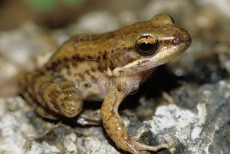

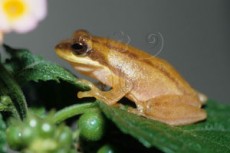

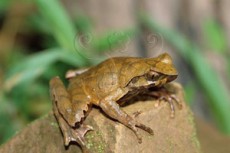
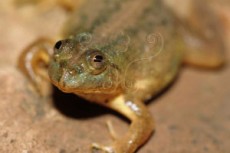
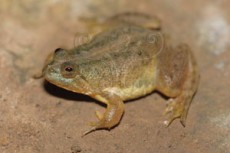
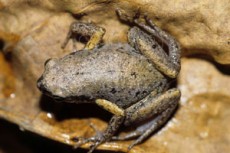 Many features that evolved from early tetrapods are related to the key transformations from water to land, and are inherited by their descendants – the amphibians. For this reason, amphibians have a real tongue (to moisten and to move food), eyelids (connected to glands nearby to moisten the cornea), an outer layer of dead cells on the skin that can be shed, first pair of real ears (and a sound producing structure – larynx), and the first vomeronasal organ – a chemoreceptor structure which is connected to the nasal cavity; the evolution continue to climax in lizards and snakes. It is hypothesized that the same features may be found in tetrapods – the ancestors of amphibians that are extinct.
Many features that evolved from early tetrapods are related to the key transformations from water to land, and are inherited by their descendants – the amphibians. For this reason, amphibians have a real tongue (to moisten and to move food), eyelids (connected to glands nearby to moisten the cornea), an outer layer of dead cells on the skin that can be shed, first pair of real ears (and a sound producing structure – larynx), and the first vomeronasal organ – a chemoreceptor structure which is connected to the nasal cavity; the evolution continue to climax in lizards and snakes. It is hypothesized that the same features may be found in tetrapods – the ancestors of amphibians that are extinct.